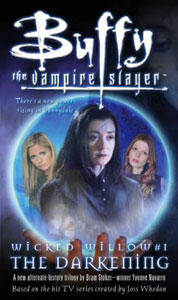Yvonne Navarro expands on the Dark Willow period of Season 6 in her “Wicked Willow” trilogy by asking “What if Willow had been evil for a longer time period?” Evil Willow is a short-lived but iconic villain in Buffyverse lore, and this alternate-reality trilogy is a way to spend more time with her, since in “Grave” (6.22), Xander talks her back from the dark side.
Using “Star Wars’ ” light side/dark side terminology is a fashionable shorthand when talking about good characters turning bad, but it’s especially apt in “The Darkening” (2004), because this book reminds me so much of “Star Wars: Episode III – Revenge of the Sith,” particularly Matthew Stover’s novelization that digs into Anakin Skywalker’s thought process as he turns to the dark side. It’s tempting to say Navarro is riffing on that material, but “Episode III” came out a full year after this book.
In particular, Willow gathers magic power by sending out a magic cat – the evocatively named sine kot diabl – to suck the magic out of supernatural beings in Sunnydale. When it returns from its nightly hunts to Willow’s magically protected abode in the warehouse district, Willow siphons the cat’s magic, as she had done with Giles in their showdown in “Two to Go” (6.21) and “Grave.” In “Episode III,” Anakin directly kills people to gain dark-side power.
The first 100 pages or so are a retelling of the TV show’s events when Willow kills Warren in “Villains” (6.20) then pursues Jonathan and Andrew for a bit and faces Buffy and Giles in the Magic Box. Then the story diverges, not via a magic dimension-jump like in “The Lost Slayer,” but rather by following a slightly different story flow. Perhaps a later book will have a timeline-resetting event, but probably not, since the “Wicked Willow” trilogy is openly advertised as “alternate history” on the covers.
The major difference between Anakin’s arc and Navarro’s Dark Willow arc is that Anakin has Darth Sidious guiding him, manipulating him, bringing out his worst instincts. In “The Darkening,” Willow does not have an outside bad influence; in fact, all of her influences are positive. Not only is the Scooby Gang trying to talk her down, but more importantly, the Ghost of Tara is in her new apartment, constantly telling her that all of her actions are wrong. With Tara in the mix, Willow should arguably come back from the dark side faster than in the TV narrative.
Willow’s evil and cruel acts include chaining up the recently ensouled Spike and Oz, who is in perpetual werewolf state; mind-controlling area magic users into forming a coven and doing her bidding; and of course fighting her former friends. She’s willing to let Buffy die except that the Ghost of Tara plays a trump card: She’ll leave Willow forever – and she’ll break up with Willow if Willow successfully resurrects Tara from death – if Willow doesn’t stop the cat from killing Buffy.

In the TV series, Willow is driven by grief over Tara’s death, and the love of her friends – Xander, in particular – brings her back from the brink. In my opinion, there’s not a strong enough reason for the divergence in “The Darkening” that causes Willow to calmly and rationally (if evilly) create her headquarters, the cat, and the coven, which she has instructed to find ways to resurrect Tara. Willow has transitioned from unfocused, rage-filled grief to an evil being.
I think Amy could’ve filled this void of a bad influence on Willow, while having the bonus effect of giving us more of this underused character, but she’s not even mentioned in the book. (In the Season 8 comics, we learn Amy is Warren’s girlfriend, and that she magically saves Warren’s life. Seeing those threads tied into “The Darkening” might’ve been fascinating. Of course, Navarro couldn’t have known what the comics would do with Amy and Warren three years down the road.)
Navarro also takes the other Scoobies down alternate paths. The best of these is Anya and Xander. Their reconciliation is always tantalizingly out of grasp on the TV series, and “Wicked Willow” allows an opportunity to show them getting back together.
Meanwhile, Giles deals with being paralyzed and confined to a wheelchair. Perhaps Dawn will be fast-tracked into being a full-fledged fighter. There aren’t any notable new twists for Buffy so far, although if she’s forced into accepting Willow as an evil enemy who must be defeated at any cost, that could be interesting in the next two books.
Interesting, but also dark, of course. That point of caution should be noted for people wading into “The Darkening.” By its very nature, there is less fun to be had from this “Buffy” spinoff adventure than most. That might be part of why the Dark Willow arc only covers three episodes. As I noted, it’s driven by grief rather than a grand plan. But another reason why it’s short might be that “Buffy” fans generally don’t want Willow to be evil for a long period. Navarro’s trilogy challenges that instinct, and while it’s an interesting “what if,” it hasn’t won me over so far.
Click here for an index of all of John’s “Buffy” and “Angel” reviews.

